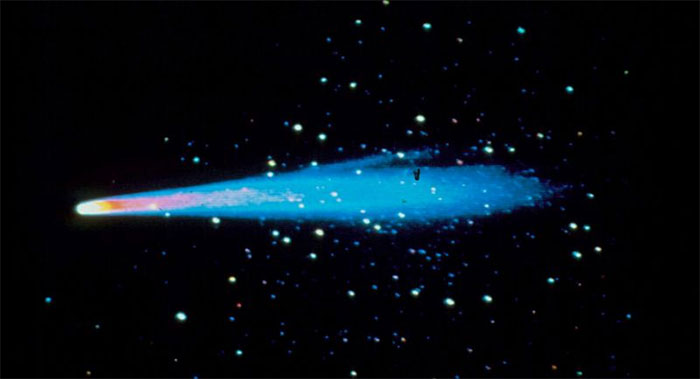Why does a comet have many tails?
In 1986 when the famous Halley comet came back, its tail was especially noticeable. A lot of people have seen it with a tail on two or more streaks. Why?
For most of the motion time, comets have no tails. Only when it comes to the sun about 2 astronomical units (300 million km), under the influence of solar wind and sunlight, the comet's head will release a layer of dust and gas stretching backwards. Comet tail.
The shape of comet tail is very diverse, can be classified into 3 typical types: Type I, Type II, Type III.
- Comet tail I is mainly composed of gases that carry charged particles, so it is also called comet tail or charged particles. The tail is straight and slender, pale blue.
- Comet tail II and type III are organized by dust, pale yellow collectively known as comet dust tail.
They are larger in width and curved than in Type I. The low degree of curvature is called the comet tail II, the degree of curvature is the tail comet type III. Because comet tails are both gaseous and dusty in the tail, when comets fly close to the Sun, they will form gas comet tails and dust comet tails at the same time. So comets with two or more tails are not uncommon. In February 1986, the comet Halley was in the time before and after going into orbit near the Sun, the shape of its tail was very different, very transformed, because of that reason.

Comets usually have two or more tails that can be confirmed.
At times the gas comet tail and the dust comet tail develop into a continuous array like the broom hanging upside down in the sky. In 1976, the comet Wayter, passing the point near the Sun, exhibited this special phenomenon.
So far the multi-tailed comet observed by humans occurred in 1744 and 1825, respectively. The last time a Swiss astronomer saw it, the comet had six tails, the next was an Australian. See, that comet has five tails.
Comets usually have two or more tails that can be confirmed. Astronomers can also capture images of the comet tail that the naked eye cannot see.
- Comet - the mystery of the universe
- Admire the climax of Comet Catalina right on the occasion of the new year
- Why don't humans have tails?
- Watching great comets shine brightly in the sky for 18 months
- Video: Comet hit the sun
- Century comets
- Comet detection is the brightest century
- Comet is brighter than the full moon visiting Earth in 2013
- Comet ISON only has dust left
- The comet of the century will not light
- Comet Lovejoy comet image from all over the world
- The ISON comet can be observed with the naked eye
- The comet 'graveyard' was discovered
- The new comet is approaching the sun
 Van Allen's belt and evidence that the Apollo 11 mission to the Moon was myth
Van Allen's belt and evidence that the Apollo 11 mission to the Moon was myth The levels of civilization in the universe (Kardashev scale)
The levels of civilization in the universe (Kardashev scale) Today Mars, the sun and the Earth are aligned
Today Mars, the sun and the Earth are aligned The Amazon owner announced a secret plan to build a space base for thousands of people
The Amazon owner announced a secret plan to build a space base for thousands of people